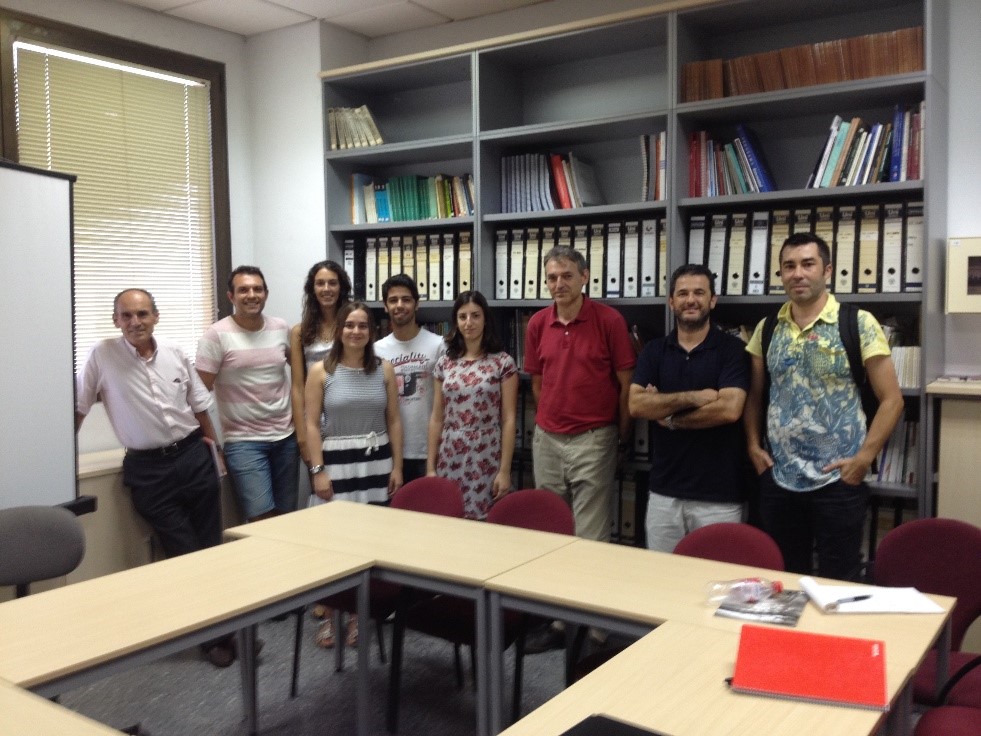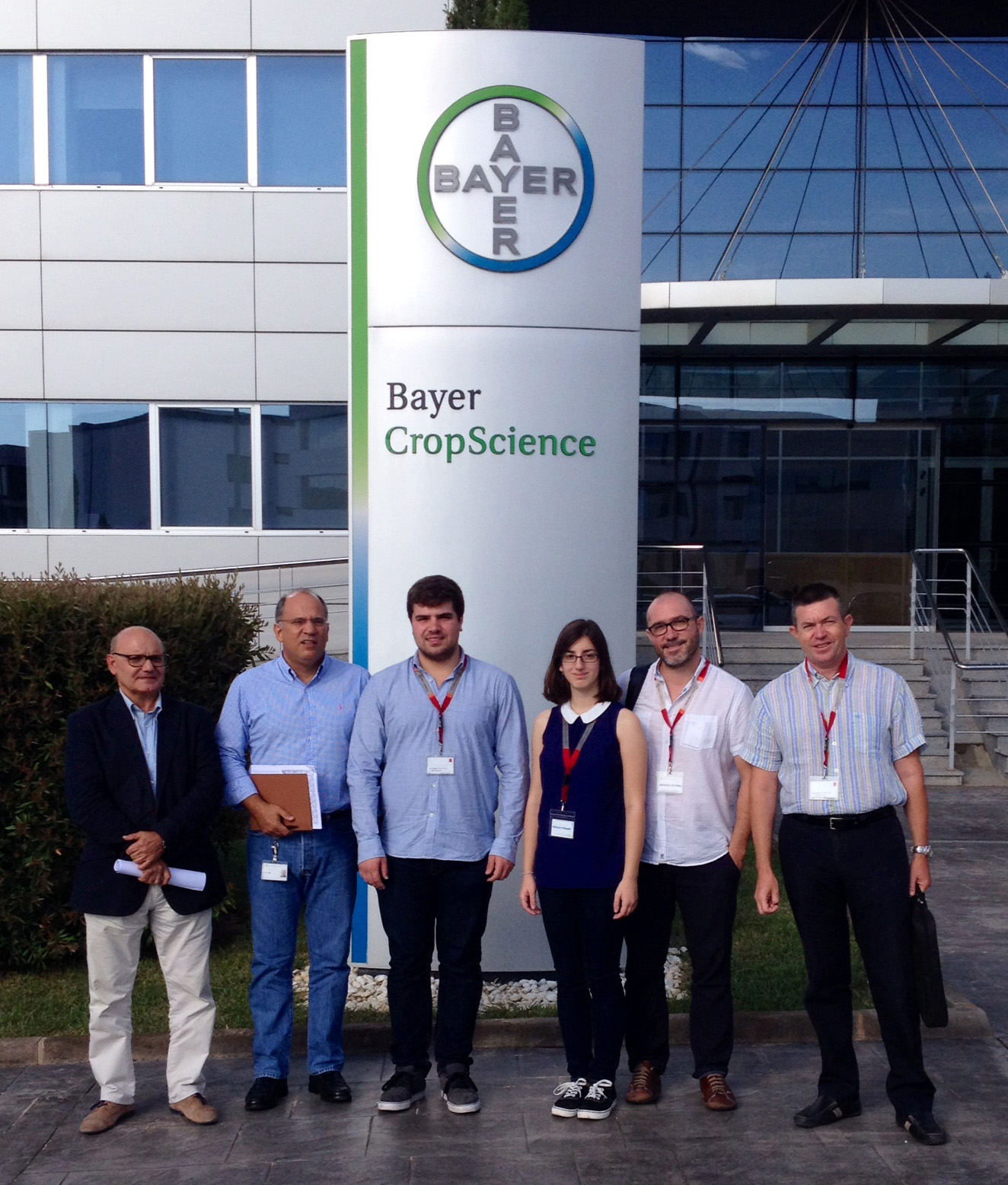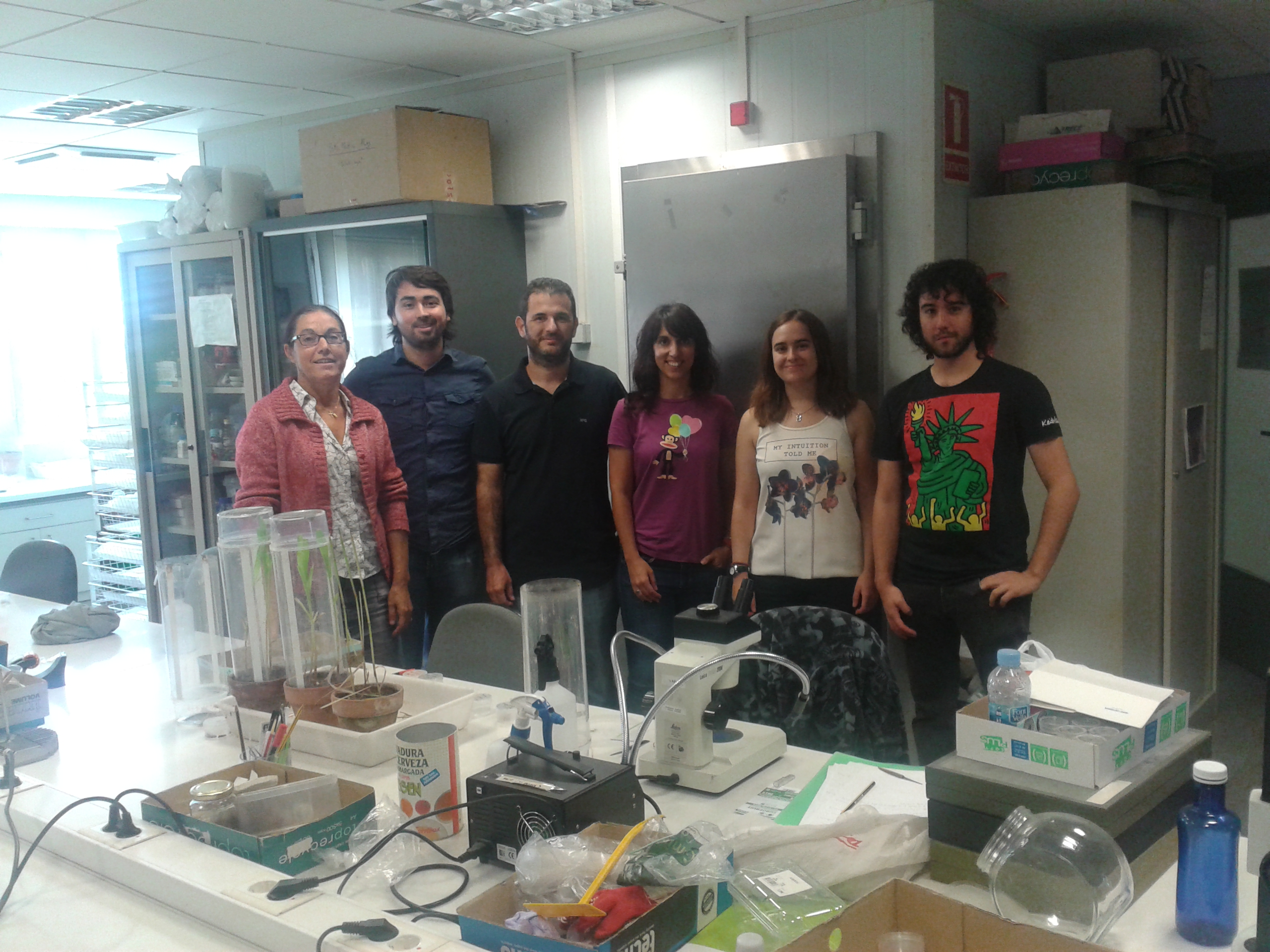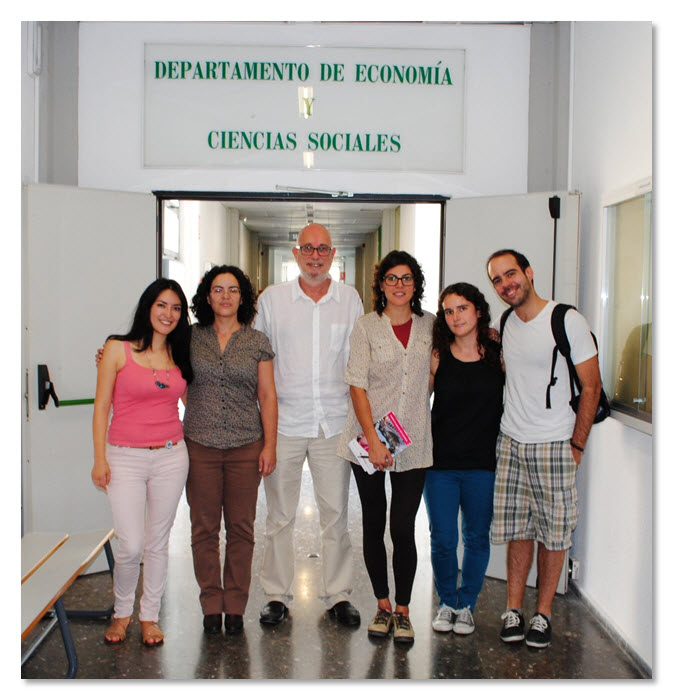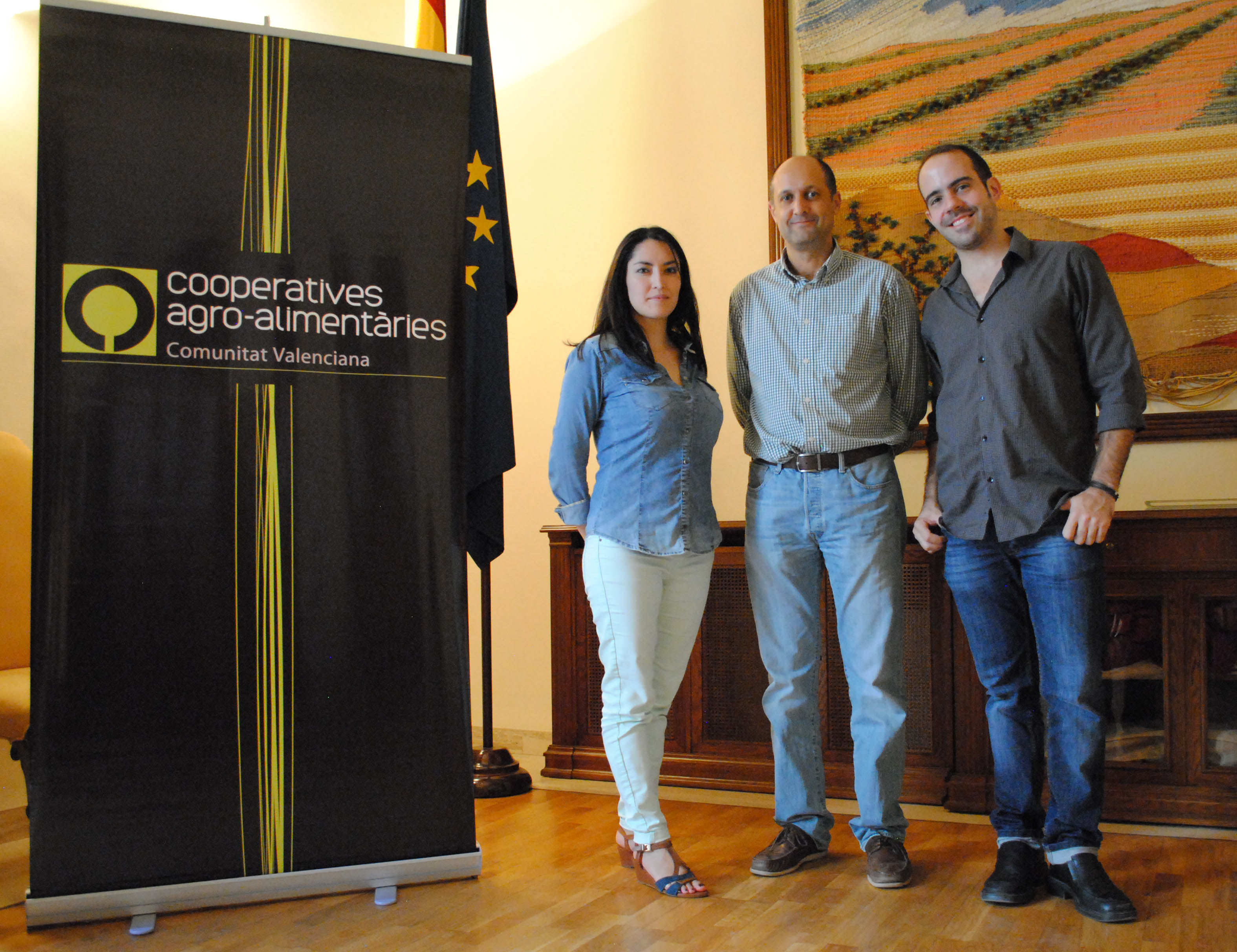Team:Valencia UPV/policy/activities
From 2014.igem.org
Alejovigno (Talk | contribs) |
|||
| (32 intermediate revisions not shown) | |||
| Line 8: | Line 8: | ||
<div align="center"><span class="coda"><roja>A</roja>ctivities</span> </div><br/><br/> | <div align="center"><span class="coda"><roja>A</roja>ctivities</span> </div><br/><br/> | ||
| + | <h3><b>Permanent meetings and activities</b></h3> | ||
| + | <br/> | ||
| + | <h3> Center for Chemical Ecology (CEQA), Valencia.</h3> | ||
| + | <br/> | ||
</html> | </html> | ||
| - | [[ | + | [[File:UPV_CEQA.jpg|500px|right]] |
<html> | <html> | ||
| - | |||
| - | |||
<p> | <p> | ||
| - | + | CEQA has expertise in the isolation and identification of semiochemicals, the formulation of pheromone attractants and controlled rate emitters.</p> | |
<p> | <p> | ||
| - | + | Jaime Primo Millo is the Director of the Agricultural Center for Chemical Ecology (CEQA), and professor of organic chemistry at UPV. Jaime Primo, Ismael Navarro, Vicente Navarro and Sandra Vacas have continuously advised the Valencia UPV iGEM team since we first met them. They are developing systems to control the principal citrus pests, and their experience on “insects sexual confusion” has been invaluable for us, and has improved the achievements of our <span class="red-bold">Sexy Plant</span> as a new pest management method. | |
| - | + | </p> | |
| + | <br/><br/> | ||
| + | <br/> | ||
| + | <h3><i>"Projects like The Sexy Plant show us the importance Synthetic Biology may have in the future of agriculture"</i></h3></html> | ||
| + | [[File:VUPV Bayer2.png|350px|left]] | ||
| + | <html> | ||
| + | <br/> | ||
| + | <h3 align="right">Bayer CropScience, Valencia</h3> | ||
| + | <br/> | ||
| + | <p>Mr. Jorge Silva is the Head of Bayer CropScience Technical Department. Jorge liked <span class="red-bold">Sexy Plant</span> as a system to fight against pests. He highlighted the necessity to find new approaches in sustainable agriculture, and that our project could have future in the market. We discussed the advances in plant synthetic biology and he concluded “projects like Sexy Plant show us the importance Synthetic Biology may have in the future of agriculture”. Jorge gave us invaluable feedback on how to improve certain details to ease the commercialization of Sexy Plant in the future, and asked us to send an executive summary of our project to Bayer CropScience headquarters in Ghent. As result of the meeting, Bayer CropScience wrote an official support letter for our project, and asked to be informed about further developments of the project in the future. </p><p align="right"> Valencia, October 2014</p> | ||
| + | |||
| + | |||
| + | <br/><br/> | ||
| + | <br/> | ||
| + | <br/> | ||
| + | <h3> Department of Crop and Forest Science, University of Lleida.</h3> | ||
| + | <br/> | ||
| + | </html> | ||
| + | [[File:2014-09-24_Lleida.jpg|350px|right]] | ||
| + | <html> | ||
| + | <br/> | ||
| + | <p>Matilde Eizaguirre has an expertise in integrated control of agricultural pests, she and her team work with S. nonagrioides moths among other species. She has been working on the effect of other specie pheromones in male response. She and her master students received our visit in the University of Lleida and they kindly accepted to provide us moth individuals which were used in Electroantennography and Wind tunnel assays. She introduced us to their colleagues and they show us their facilities and homemade devices for biologically testing pheromones. All of them were very enthusiastic about the project and they could not wait to find out more about the <span class="red-bold">Sexy Plant</span>.</p> | ||
| + | |||
| + | |||
| + | <br/><br/> | ||
| + | <br/><br/> | ||
| + | <br/><br/> | ||
| + | <h3><b>Interviews</b></h3> | ||
| + | <br/><br/> | ||
| - | |||
</html> | </html> | ||
[[Image:VUPV_Coque.jpg|400px|right]] | [[Image:VUPV_Coque.jpg|400px|right]] | ||
<html> | <html> | ||
| - | <h3><i> | + | <h3><i>“Sexy Plant could be a good approach to reduce the costs of pheromone production” </i></h3> |
| + | |||
| + | <p>Jose Maria Garcia Alvarez-Coque is a social researcher and Director of the Sustainable Agriculture group, at the Universitat Politècnica de Valencia (UPV). </p> | ||
<p> | <p> | ||
| - | + | He considers the currently pheromone synthesis as an expensive method to produce insect pheromones. “Sexy Plant could be a good approach to reduce the costs of pheromone production”. This project is another ecological way to manage pests, such as the production of auxiliary insects to protect crops. In addition, Sexy Plant can be a safe, sustainable and environmentlly friendly method, as far as it respects agricultural and environmental specifications. <span class="red-bold">Sexy Plant</span> modules like Identity Preservation or Sterility are characteristics that assist the long-term use of this plant. </p><br/> | |
| + | <p align="right"> Valencia, September 2014</p> | ||
| + | <br/><br/> | ||
| + | <br/><br/> | ||
| + | </html> | ||
| + | [[Image:UPV_Cooperativa.jpg|400px|right]] | ||
| + | <html> | ||
| + | |||
| + | <h3><i>“We have been using sexual confusion as a pest management method in rice crops for the last 20 years” </i></h3> | ||
<p> | <p> | ||
| - | + | Paco Girona is agriculture engineer at Cooperatives for Agrofood industry (FECOAV). He makes efforts to extend the use of ecological pest methods over some typical crops in Valencia, Spain. </p> | |
| - | <p> Valencia, | + | <p> |
| - | + | Around the Albufera Natural Park in Valencia, the cycle sown rice starts in May when the farmers should start protecting their crops from the <i>Chilo</i> lepidopter (moth) pest. During the first days of May, technicians place pheromone sticks between rice plants to release the Chilo female moth pheromone into the environment. The planted area is around 15,000 Ha of crop, and they are protected by 462,960 pheromone sticks. This technique has been used for the last 20 years, and the economic losses have been cut down to approximately a mere 0.5%. Paco Girona explains that Sexy Plant coul be a wonderful alternative to chemically synthetized pheromone sticks, specially during its assembly, the most hazardous part of its production. “If you get the <span class="red-bold">Sexy Plant</span>, I take my hat off” </p> | |
| + | <p align="right"> Valencia, October 2014</p> | ||
| + | <br/><br/> | ||
| + | <p>Our team also talked with Professor Sam Tothill, Professor of Biosensors in Health at Cranfield University, United Kingdom. Her current research mainly focuses in biosensors for microbial contaminants and pathogen's (bacteria, viruses, fungi) and their toxins. We really appreciated her feedback as part of her research consist in the detection of contaminants such as pesticides in food. We discussed about safety issues and how could our project be implemented in agriculture. She really liked the <span class="red-bold">Sexy Plant</span> project and wished our team succeeded at iGEM. </p> | ||
| + | <p align="right"> Cranfield, October 2014</p> | ||
</div> | </div> | ||
</br></br></div> | </br></br></div> | ||
Latest revision as of 03:31, 18 October 2014
Policy and Practices > Activities
Permanent meetings and activities
Center for Chemical Ecology (CEQA), Valencia.
CEQA has expertise in the isolation and identification of semiochemicals, the formulation of pheromone attractants and controlled rate emitters.
Jaime Primo Millo is the Director of the Agricultural Center for Chemical Ecology (CEQA), and professor of organic chemistry at UPV. Jaime Primo, Ismael Navarro, Vicente Navarro and Sandra Vacas have continuously advised the Valencia UPV iGEM team since we first met them. They are developing systems to control the principal citrus pests, and their experience on “insects sexual confusion” has been invaluable for us, and has improved the achievements of our Sexy Plant as a new pest management method.
"Projects like The Sexy Plant show us the importance Synthetic Biology may have in the future of agriculture"
Bayer CropScience, Valencia
Mr. Jorge Silva is the Head of Bayer CropScience Technical Department. Jorge liked Sexy Plant as a system to fight against pests. He highlighted the necessity to find new approaches in sustainable agriculture, and that our project could have future in the market. We discussed the advances in plant synthetic biology and he concluded “projects like Sexy Plant show us the importance Synthetic Biology may have in the future of agriculture”. Jorge gave us invaluable feedback on how to improve certain details to ease the commercialization of Sexy Plant in the future, and asked us to send an executive summary of our project to Bayer CropScience headquarters in Ghent. As result of the meeting, Bayer CropScience wrote an official support letter for our project, and asked to be informed about further developments of the project in the future.
Valencia, October 2014
Department of Crop and Forest Science, University of Lleida.
Matilde Eizaguirre has an expertise in integrated control of agricultural pests, she and her team work with S. nonagrioides moths among other species. She has been working on the effect of other specie pheromones in male response. She and her master students received our visit in the University of Lleida and they kindly accepted to provide us moth individuals which were used in Electroantennography and Wind tunnel assays. She introduced us to their colleagues and they show us their facilities and homemade devices for biologically testing pheromones. All of them were very enthusiastic about the project and they could not wait to find out more about the Sexy Plant.
Interviews
“Sexy Plant could be a good approach to reduce the costs of pheromone production”
Jose Maria Garcia Alvarez-Coque is a social researcher and Director of the Sustainable Agriculture group, at the Universitat Politècnica de Valencia (UPV).
He considers the currently pheromone synthesis as an expensive method to produce insect pheromones. “Sexy Plant could be a good approach to reduce the costs of pheromone production”. This project is another ecological way to manage pests, such as the production of auxiliary insects to protect crops. In addition, Sexy Plant can be a safe, sustainable and environmentlly friendly method, as far as it respects agricultural and environmental specifications. Sexy Plant modules like Identity Preservation or Sterility are characteristics that assist the long-term use of this plant.
Valencia, September 2014
“We have been using sexual confusion as a pest management method in rice crops for the last 20 years”
Paco Girona is agriculture engineer at Cooperatives for Agrofood industry (FECOAV). He makes efforts to extend the use of ecological pest methods over some typical crops in Valencia, Spain.
Around the Albufera Natural Park in Valencia, the cycle sown rice starts in May when the farmers should start protecting their crops from the Chilo lepidopter (moth) pest. During the first days of May, technicians place pheromone sticks between rice plants to release the Chilo female moth pheromone into the environment. The planted area is around 15,000 Ha of crop, and they are protected by 462,960 pheromone sticks. This technique has been used for the last 20 years, and the economic losses have been cut down to approximately a mere 0.5%. Paco Girona explains that Sexy Plant coul be a wonderful alternative to chemically synthetized pheromone sticks, specially during its assembly, the most hazardous part of its production. “If you get the Sexy Plant, I take my hat off”
Valencia, October 2014
Our team also talked with Professor Sam Tothill, Professor of Biosensors in Health at Cranfield University, United Kingdom. Her current research mainly focuses in biosensors for microbial contaminants and pathogen's (bacteria, viruses, fungi) and their toxins. We really appreciated her feedback as part of her research consist in the detection of contaminants such as pesticides in food. We discussed about safety issues and how could our project be implemented in agriculture. She really liked the Sexy Plant project and wished our team succeeded at iGEM.
Cranfield, October 2014
 "
"
